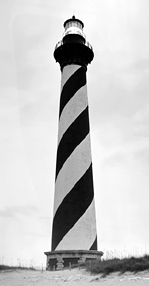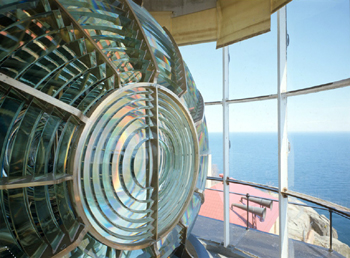 |
| Cape Hatteras Lighthouse |
In 1868, Congress approved a measure to rebuild a lighthouse at Cape Hatteras, North Carolina. The original structure, which had stood on the outer banks for seventy years, had proven to be so ineffective as to warrant the construction of an entirely new lighthouse. Commenting on the light, a U.S. Navy lieutenant complained in 1851 that “Hatteras light, the most important on our coast is, without doubt, the worst light in the world.” Such strong words reflect the vital importance of functional navigational aides on that stretch of America’s coast, known ominously as the “Graveyard of the Atlantic.” Diamond Shoals, an underwater menace of shifting sand bars, rests directly off the Hatteras coast and extends roughly fourteen miles out to sea. Nearby, the warm Gulf Stream ocean current collides with the colder Labrador Current, creating ideal conditions for powerful ocean storms and sea swells.
The original 112-ft., 18-lamp lighthouse at Cape Hatteras was designed to warn mariners of the “Graveyard” for up to 18 miles out to sea. However, the beacon was frequently too dim to be seen before ships helplessly foundered upon the treacherous shallows. As a result, hundreds of ships sank off the Hatteras coast, including the U.S.S. Monitor, famous ironclad of the American Civil War.
At the behest of mariners and officers of the U.S. Navy, Congress appropriated $80,000 to the Light-House Board to construct a new beacon at Cape Hatteras in 1868. The Light-House Board was a federal agency under the direction of the Treasury Department but was headed by a multi-agency committee. The Board consisted of two Army Engineers, two Navy officers, two civilian scientists, and one additional officer from both the Army and Navy to serve as secretaries. Congress established the Board in 1852 for the purpose of creating a unified, continuous system of navigational aides along the coasts. Prior to 1852, lighthouse construction generally rested with local authorities, ultimately leading to a disjointed, ineffective national system. Under the Light-House Board, Navy officers determined where new lighthouses were needed; Army Engineers selected exact locations, designed, and built them; and civilian scientists developed new technologies and techniques for displaying bright, consistent beacons.
 |
 |
| Sinking of the USS Monitor |
An example of a Fresnel Lens that would have been installed
in the Cape Hatteras Lighthouse |
Under the direction of Brevet Brigadier General J. H. Simpson of the U.S. Army Corps of Engineers, the new Cape Hatteras lighthouse was completed in just two years at a cost of $167,000. It was located only 600 feet from the old structure but stood 72 feet taller for a total height of 184 feet above sea level. Outfitted with a state-of-the-art Fresnel lens, the beacon could be seen for roughly 22 miles at sea and its distinctive black and white spiraled daymark set Hatteras apart from all others. When completed, Hatteras was the tallest lighthouse in the world.
* * *
January 2008